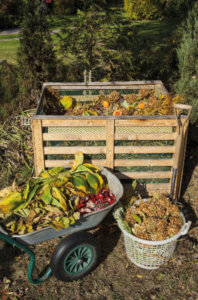Garden Gold

Forget diamonds – the gardener’s best friend is compost, and with peat-based compounds a no-no, what else can you use?
All of us are trying to be more organic when it comes to gardening, and with sales of peat-based compost set to be banned from 2024, we might as well be prepared. There really is no reason to wait.
Matt Felix, Sunnyside Rural Trust’s site coordinator at Northchurch, says: ‘Here at Sunnyside Rural Trust we attempt a process of hot composting within six large bays. Rapid decomposition takes place at high temperatures, allowing us to use a mix of green and animal (goats, pigs, sheep) waste, layering the compost with equal amounts each week. At the end of each month the compost gets turned into the new bay, leaving the first bay empty for the new waste. This method allows for faster production (six months) of larger amounts of compost to be used in the polytunnels all year round, and is rich in nitrogen, potassium, and phosphorus and should be weed-free, thanks to the heat created.
‘We then celebrate the ‘No Dig Method’. The principle of no-dig is to not disturb the natural soil any more than the top 5cm, and then apply compost as a mulch rather than digging it in as would happen traditionally. This benefits the plants significantly and our weeds are kept under control, so no weed killer needed either!
‘Growing no-dig works for veg plots and flowerbeds alike, so if you are interested in learning more, the current lead in UK no-dig work is Charles Dowding [Monty Don calls him the guru of no-dig gardening].’
What are the alternatives?
If you want to buy peat-free compost, you have a few choices:
- Wood fibre: This includes composted bark, paper waste and sawdust. It offers a low pH and good drainage.
- Coir: This coconut fibre is a waste product and is mostly imported from Sri Lanka. While it can be good at retaining water, it is not so good at retaining nutrients, so be careful to feed your plants as necessary.
- Green waste: Made by councils and some private companies from the green waste harvested from household waste collections. Keep an eye out for free compost on offer from Dacorum Council.
Choosing a compost bin
There are all kinds of bins to choose from. And if you have plenty of space in your garden, you have lots of choice. However, if your garden space is limited, here’s a few options…
- Wormery: If you buy one, it will most likely stand on legs and fit easily on a patio. Brandling worms are kept inside and you get not only rich compost but liquid fertiliser too.
- Compost bags: Special compost bags are made from a breathable fabric that allows the oxygen to get in.
- Bokashi bins: Rather than decomposing, the material in these Japanese-developed bins ferments. It’s a much quicker process – you can see results in just 10 days.
- CompoSphere Rollable Tumblr: This round bin can be pushed around to help the compost mix together – and can also be rolled out of the way when necessary.
Recipe for homemade compost
Ingredients
 You need a good mix of green and brown components to make a balanced mix:
You need a good mix of green and brown components to make a balanced mix:
- Greens: fruit and veg peelings; grass cuttings; coffee grounds; fresh manure; green plant cuttings.
- Browns: leaves; hay; straw; shredded paper; cardboard; chopped up woody prunings; eggshells; teabags; sawdust.
- Never add: whole eggs; cooked meat/bones; fatty food waste; dairy products; dog or cat waste, or treated wood (such as fence panels).
Method
- Find a space that is out of the way. You can use a compost bin if you want. This is advisable if the compost can be easily seen from the rest of the garden, just because it will look nicer.
- Add waste as and when you have it – try to keep a good mix of green and brown or it will be too wet/too dry.
- Every so often, check the consistency. If it’s too dry, you can water it with the hose. If it’s too wet, fork in some more matter from the ‘brown’ list.
- The compost will take at least six months to become the brown, crumbly compost you need. If it is not rotting, you may need to turn it and fork it to add more oxygen.
- Dig in to borders, or use as a mulch around plants. Use a mix of compost and soil in containers.

